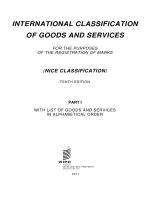Project management toolbox tools and techniques for the practicing project manager 2016
Bạn đang xem bản rút gọn của tài liệu. Xem và tải ngay bản đầy đủ của tài liệu tại đây (2.45 MB, 480 trang )
PROJECT
MANAGEMENT
TOOLBOX
Second Edition
Russ J. Martinelli
Dragan Z. Milosevic
Cover image: Wiley
Cover design: abstract background © yewkeo/iStockphoto
This book is printed on acid-free paper.
Copyright © 2016 by Russ J. Martinelli and Dragan Z. Milosevic
Published by John Wiley & Sons, Inc., Hoboken, New Jersey
Published simultaneously in Canada
No part of this publication may be reproduced, stored in a retrieval system, or transmitted in any form
or by any means, electronic, mechanical, photocopying, recording, scanning, or otherwise, except as
permitted under Section 107 or 108 of the 1976 United States Copyright Act, without either the prior
written permission of the Publisher, or authorization through payment of the appropriate per-copy fee
to the Copyright Clearance Center, 222 Rosewood Drive, Danvers, MA 01923, (978) 750-8400, fax (978)
646-8600, or on the web at www.copyright.com. Requests to the Publisher for permission should be
addressed to the Permissions Department, John Wiley & Sons, Inc., 111 River Street, Hoboken, NJ 07030,
(201) 748-6011, fax (201) 748-6008, or online at www.wiley.com/go/permissions.
Limit of Liability/Disclaimer of Warranty: While the publisher and author have used their best efforts in
preparing this book, they make no representations or warranties with the respect to the accuracy or
completeness of the contents of this book and specifically disclaim any implied warranties of
merchantability or fitness for a particular purpose. No warranty may be created or extended by sales
representatives or written sales materials. The advice and strategies contained herein may not be
suitable for your situation. You should consult with a professional where appropriate. Neither the
publisher nor the author shall be liable for damages arising here from.
For general information about our other products and services, please contact our Customer Care
Department within the United States at (800) 762-2974, outside the United States at (317) 572-3993 or
fax (317) 572-4002.
Wiley publishes in a variety of print and electronic formats and by print-on-demand. Some material
included with standard print versions of this book may not be included in e-books or in
print-on-demand. If this book refers to media such as a CD or DVD that is not included in the version
you purchased, you may download this material at . For more
information about Wiley products, visit www.wiley.com.
Library of Congress Cataloging-in-Publication Data:
ISBN 978-1-118-97312-7 (hard back), 978-1-118-97321-9 (ePDF), 978-1-118-97320-2 (ePUB)
and 978-1-119-17482-0 (oBook)
CONTENTS
Preface
xv
Acknowledgments
PART I:
xvii
THE PM TOOLBOX
1 INTRODUCTION TO THE PM TOOLBOX
1
3
Enabling Business and Project Strategy 5
Project Management Methodologies and Processes 7
Constructing and Adapting a PM Toolbox 9
Secure Strategic Alignment 10
Customize the PM Toolbox 12
Continuously Improve the PM Toolbox 20
References 21
PART II:
PROJECT INITIATION TOOLS
2 PROJECT SELECTION
23
25
The Benefits Map 25
Enabling Benefits Management 26
Developing a Benefits Map 28
Using a Benefits Map 29
Variations 30
Benefits 31
Economic Methods 31
Payback Time 31
Net Present Value 31
Internal Rate of Return 33
Using Economic Methods 33
Benefits of Economic Methods 34
iii
iv
CONTENTS
Scoring Models 34
Developing a Scoring Model 34
Using a Scoring Model 39
Benefits 40
Voting Models 40
Developing a Voting Model 41
Using the Voting Model 42
Benefits 45
Pairwise Ranking 46
Developing a Pairwise Ranking Tool 47
Using the Pairwise Ranking Matrix 48
Benefits 49
The Alignment Matrix 49
Developing the Alignment Matrix 50
Variations 51
Benefits 52
References 52
3 PROJECT INITIATION
Checklist Questions for Project Initiation 55
Developing Checklist Questions for Project
Initiation 56
Using the Checklist Questions 57
The Goals Grid 57
Developing a Goals Grid 58
Using the Goals Grid 59
Benefits 60
Responsibility Matrix 60
Developing a Responsibility Matrix 61
Using the Responsibility Matrix 63
Benefits 64
Complexity Assessment 64
Developing the Complexity Assessment 65
Using the Complexity Assessment 67
Benefits 67
55
CONTENTS
v
The Project Business Case 68
Developing the Project Business Case 68
Using the Project Business Case 70
Benefits 71
The Project Charter 71
Developing a Project Charter 71
Using a Project Charter 76
Variations 77
Benefits 77
References 78
PART III:
PROJECT PLANNING TOOLS
4 PROJECT REQUIREMENTS
The Elicitation Plan 84
Developing an Elicitation Plan 86
Using the Elicitation Plan 89
Benefits 90
Requirements Specification 91
Specifying a Requirement Using Planguage 91
Using the Requirements Specificiation 93
Benefits 96
The Product Requirements Document 96
Developing a Product Requirements
Document 97
Using the PRD 101
Benefits 102
Requirements Ambiguity Checklist 102
Using the Requirements Ambiguity
Checklist 104
Benefits 106
Requirements Baseline 106
Establishing a Requirements Baseline 107
Establish a Requirements Change Board 107
Benefits 108
References 109
81
83
vi
CONTENTS
5 SCOPE PLANNING
111
Project SWOT Analysis 111
Performing a Project SWOT Analysis 112
Using a Project SWOT Analysis 116
Benefits 117
The Scope Statement 118
Developing a Scope Statement 118
Using a Scope Statement 124
Variations 124
Benefits 125
The Work Breakdown Structure 126
Constructing a Project WBS: A Top-Down
Approach 128
Establish the WBS Level of Detail 130
Constructing a Project WBS: A Bottom-Up
Approach 134
Using the WBS 135
Benefits 136
The Product Breakdown Structure 137
Constructing a Product Breakdown
Structure 137
Using the PBS 141
Benefits 141
References 142
6 SCHEDULE DEVELOPMENT
The Gantt Chart 146
Developing a Gantt Chart 146
Using the Gantt Chart 149
Benefits 149
The Milestone Chart 150
Developing a Milestone Chart 151
Using the Milestone Chart 153
Benefits 154
145
CONTENTS
vii
The Critical Path Method Diagram 154
Constructing a CPM Diagram 155
Using the CPM Diagram 160
Benefits 161
Variations 161
The Time-Scaled Arrow Diagram 162
Developing a TAD 162
Using a TAD 167
Benefits 168
The Critical Chain Schedule 168
Developing a Critical Chain Schedule 169
Using the Critical Chain Schedule 172
Benefits 173
The Hierarchical Schedule 173
Constructing a Hierarchical Schedule 174
Using a Hierarchical Schedule 176
Benefits 177
Line of Balance 177
Developing a Line-of-Balance Schedule 178
Using the LOB 180
Benefits 181
Choosing Your Scheduling Tools 181
References 183
7 COST PLANNING
The Cost-Planning Map 185
Developing a Cost-Planning Map 186
Using the Cost-Planning Map 191
Benefits 191
Analogous Estimate 191
Developing an Analogous Estimate 192
Using an Analogous Estimate 193
Benefits 193
185
viii
CONTENTS
Parametric Estimate 194
Developing Parametric Estimates 194
Using Parametric Estimates 198
Benefits 198
Bottom-up Estimate 199
Developing Bottom-Up Estimates 200
Using Bottom-Up Estimates 202
Benefits 202
The Cost Baseline 203
Developing a Cost Baseline 203
Using the Cost Baseline 207
Benefits 208
Choosing a Cost-Planning Tool 211
References 211
PART IV:
PROJECT IMPLEMENTATION TOOLS
8 SCOPE MANAGEMENT
Project Scope Control System 217
Establishing a Project Scope Control
System 217
Using the Project Scope Control System 220
Benefits 223
Project Change Request 223
Developing a Project Change Request 224
Using the Project Change Request 228
Benefits 229
The Project Change Log 229
Developing a Project Change Log 230
Using the Project Change Log 232
Benefits 233
The Scope Control Decision Checklist 233
Developing a Scope Control Decision
Checklist 233
213
215
CONTENTS
ix
Using the Scope Control Decision
Checklist 234
Benefits 235
References 235
9 SCHEDULE MANAGEMENT
The Burn Down Chart 239
Developing the Burn Down Chart 239
Using the Burn Down Chart 240
Benefits 242
The Slip Chart 243
Developing the Slip Chart 244
Using the Slip Chart 246
Benefits 246
The Buffer Chart 247
Developing the Buffer Chart 248
Using the Buffer Chart 249
Benefits 250
The Jogging Line 251
Constructing a Jogging Line 252
Using the Jogging Line 255
Variations 256
Benefits 256
The Milestone Prediction Chart 257
Constructing the Milestone Prediction
Chart 258
Using the Milestone Prediction Chart 260
Benefits 260
B-C-F Analysis 261
Performing the B-C-F Analysis 262
Using the B-C-F Analysis 264
Benefits 265
Schedule Crashing 265
Performing Schedule Crashing 265
Using Schedule Crashing 269
Benefits 269
237
x
CONTENTS
Choosing Your Schedule Management Tools 269
References 270
10 COST MANAGEMENT
273
Cost Management Plan 275
Developing the Cost Management Plan 275
Using the Cost Management Plan 276
The Budget Consumption Chart 276
Developing the Budget Consumption
Chart 277
Using the Budget Consumption Chart 278
Variations 279
Benefits 279
Earned Value Analysis 280
Performing Earned Value Analysis 281
Using Earned Value Analysis 292
Variations 293
Benefits 293
Milestone Analysis 294
Performing a Milestone Analysis 295
Using the Milestone Analysis 297
Benefits 297
Choosing Your Cost Management Tools 297
References 298
11 AGILE PROJECT EXECUTION
Contributed by
Peerasit Patanakul
James Henry
Jeffrey A. Leach
Scrum Basics 302
Product Backlog and Sprint Backlog 304
Information on the Backlogs 304
Populating Backlogs 304
Benefits 306
301
CONTENTS
xi
Release Planning 307
The Release-Planning Event 308
Initial Draft Release Plan 309
Final Release Plans 309
HIP Sprint 310
Release Planning versus Sprint Planning 310
Benefits 311
The Daily Scrum Meeting 311
Organizing a Daily Scrum Meeting 312
Benefits 312
Sprint Task Board 313
Using the Sprint Task Board 313
Benefits 314
The Sprint Burn Down Chart 315
Developing a Sprint Burn Down Chart 315
Using a Sprint Burn Down Chart 316
Benefits 317
The Sprint Retrospective Meeting 317
Organizing a Sprint Retrospective
Meeting 318
Using a Sprint Retrospective Meeting 318
Benefits 320
Concluding Remarks 320
References 321
PART V:
PROJECT REPORTING AND
CLOSURE TOOLS
12 PERFORMANCE REPORTING
Project Reporting Checklist 325
Developing the Project Reporting
Checklist 326
Using the Project Reporting Checklist 326
Benefits 326
323
325
xii
CONTENTS
The Project Strike Zone 328
Developing the Project Strike Zone 328
Using the Project Strike Zone 330
Benefits 332
The Project Dashboard 332
Designing a Project Dashboard 334
Using the Project Dashboard 335
Benefits 336
The Summary Status Report 337
Developing a Summary Status Report 337
Using the Summary Status Report 342
Benefits 343
The Project Indicator 343
Developing the Project Indicator 345
Using the Project Indicator 346
Variations 346
Benefits 348
Choosing Your Reporting Tools 349
References 349
13 PROJECT CLOSURE
Contributed by Tim Rahschulte, PhD
Understanding Project Closure 351
Project Closing Activities 353
Project Closure Plan and Checklist 356
Developing the Plan and Checklist 358
Using the Closure Plan and Checklist 362
Benefits 362
The Project Closure Report 363
Developing the Project Closure Report 363
Using the Project Closure Report 365
Benefits 365
Postmortem Review 366
Conducting the Postmortem Review 366
Using the Postmortem Review 369
351
CONTENTS
xiii
Variations 371
Benefits 372
Concluding Remarks 373
References 373
PART VI:
RISK AND STAKEHOLDER MANAGEMENT
TOOLS
14 MANAGING PROJECT RISK
Risk Management Plan 378
Developing a Risk Management Plan 378
Using the Risk Management Plan 385
Benefits 386
The Risk Identification Checklist 387
Developing a Risk Identification Checklist 387
Using a Risk Identification Checklist 389
Benefits 389
The Risk Register 390
Creating a Risk Register 390
Using the Risk Register 393
Benefits 394
The Risk Assessment Matrix 394
Developing a Risk Assessment Matrix 395
Using the Risk Assessment Matrix 397
Variations 398
Benefits 398
Monte Carlo Analysis 399
Performing a Monte Carlo Analysis 400
Using the Monte Carlo Analysis 408
Benefits 409
The Decision Tree 409
Analyzing the Decision Tree 410
Using Decision Trees 413
Benefits 414
375
377
xiv
CONTENTS
The Risk Dashboard 414
Developing the Risk Dashboard 414
Using the Risk Dashboard 418
Benefits 418
Choosing Your Risk Management Tools 420
References 420
15 INFLUENCING PROJECT STAKEHOLDERS
423
The Stakeholder Management Plan 423
Developing a Stakeholder Management
Plan 424
Using the Stakeholder Management Plan 427
Benefits 427
The Stakeholder Map 428
Developing a Stakeholder Map 428
Using the Stakeholder Map 431
Benefits 431
The Stakeholder Analysis Table 431
Developing a Stakeholder Analysis Table 433
Using the Stakeholder Analysis Table 434
Benefits 435
The Stakeholder Evaluation Matrix 436
Developing a Stakeholder Evaluation
Matrix 438
Using the Stakeholder Evaluation Matrix 439
Variations 441
Benefits 443
The Stakeholder Strategy Matrix 444
Developing a Stakeholder Strategy Matrix 444
Using the Stakeholder Strategy Matrix 446
Benefits 447
Choosing Your Stakeholder Management Tools 447
References 449
Final Thoughts on The PM Toolbox 449
Index
451
PREFACE
M
uch has changed since the publication of the first edition of this book, as the
field of project management (PM) is continually evolving. Part of that evolution
has involved a new approach for selecting project management tools from an
ad-hoc “choose as you use” approach to a more systematic approach of creating a PM
Toolbox that can be applied to many project situations. From this perspective, we feel
fortunate to have been part of the recent project management evolution.
We also feel fortunate to have had the opportunity to work firsthand with many
project managers and project office directors as they set about the task of creating their
initial PM Toolboxes based on the teachings of this text. Our personal understanding of
how project management is evolving and how it affects the needs for PM tools has been
greatly enhanced. This new understanding became the basis for the changes introduced
in this second edition.
The most significant changes in this edition are in four areas. First, we have focused
the content of the book on the fundamental project management practice areas to
create more depth in content. Next, we have maintained the traditional view of project
management tools but have also provided a contemporary set of tools that reflect the
changes in PM practices. Then, to strengthen an area that has created some of the most
positive reader feedback, we have enhanced the various tips, tricks, and examples found
throughout the book. Finally, we worked to create a stronger message concerning the
importance of creating a PM Toolbox that enables stronger alignment between business strategy and project execution, between strategic goals and project deliverables,
and between the work of senior leaders and project managers.
This book has established itself as both educational lecture material and an industry
practice reference, which we hope to maintain with this second edition. Our heartfelt
thanks to the existing and future readers of this book; we hope you find it both enjoyable
and useful to read.
Of course, we would like to hear from you directly and get your feedback at
www.programmanagement-academy.com. Supplemental materials and templates can
be found on our web site as well.
xv
ACKNOWLEDGMENTS
W
e would like to thank the many people who have helped in making this book
a reality.
To our contributing authors, whose subject matter expertise is appreciated:
Debra Lavell, Jim Waddell, Tim Rahschulte, Peerasit Patanakul, James Henrey, and Jeffrey
Leach.
To the team at John Wiley & Sons, who continue to provide outstanding support and
guidance. In particular, we want to thank our executive editor, Margaret Cummins, and
our assistant editor, Amanda Shettleton. Your continued partnership and collaboration
is greatly valued.
To our many colleagues and coworkers who have contributed to the concepts presented in this work in many ways.
To our families who provide the support and encouragement necessary to complete
the writing process.
We are truly blessed to be associated with such a wonderful and supportive community of people!
xvii
PART
I
The PM
Toolbox
1
INTRODUCTION
TO THE PM TOOLBOX
onventional wisdom holds that project management (PM) tools are enabling
devices that assist a project manager in reaching an objective or, more specifically, a project deliverable or outcome. While this traditional role of PM tools is
more than meaningful, we believe that there is greater opportunity to provide value to
an organization and its project managers. In particular, each PM tool can be part of a set
of tools that makes up a project manager’s PM Toolbox.
The PM Toolbox, then, serves a higher purpose: (1) to increase efficiency of the
project players, (2) to provide the right information to support problem-solving and
decision-making processes, and (3) to help establish and maintain alignment among
business strategy, project strategy, and project execution outcomes.
Project management tools support the practices, methods, and various processes
used to effectively manage a project.1 They are enabling devices for the primary players
on a project: the project manager, the specialists who make up the project team, the
executive leadership team, and the governance body.
PM tools include procedures, techniques, and job aids by which a project deliverable
is produced or project information is created. Similarly, A Guide to the Project Management Body of Knowledge and other sources use the phrase “tools and techniques” in place
of what we define as PM tools.2
PM tools may be either qualitative or quantative in nature. To illustrate, consider
two examples: the team charter and Monte Carlo analysis. They differ in the type of
information they process. The team charter provides a systematic procedure to process
qualitative information about authorizing a team to implement a project. Monte Carlo
analysis is a risk-planning tool that uses an algorithm to quantify risks. The heart of both
the qualitative and quantitative groups of tools—and all PM tools belong to one of these
groups—is in their systematic procedure.
Note that we don’t talk about software tools here. True, many PM tools that we discuss in this book exist in a software format. However, our focus is not on tool formats.
Rather, we concentrate on the substance of PM tools: the use of tools to manage projects
more effectively and efficiently.
The design of a PM Toolbox should mirror the approach an organization takes for
establishing standardized project management methodologies and processes. A highly
C
3
4
INTRODUCTION TO THE PM TOOLBOX
standardized set of methods and processes will in turn require an equally high level of
standardization of the PM Toolbox. Less standardization introduces more variability in
PM Toolbox design and use, and therefore more possibility for inconsistent results.
In practice, as organizations strive to grow and mature, project execution efficiency
and repeatability become increasingly important as the leaders of the organization look
for consistency in achieving business results. This means that project managers must be
armed with the right tools—those that support the business strategy, project strategy,
and project management methodologies and processes. It also means that the same
tools should be used across the gamut of projects with limited exceptions.
Standardization of a firm’s PM Toolbox does not happen overnight. Rather, it is
an evolutionary process. In a practical sense, PM Toolboxes will look quite ad hoc at
first. The tendency is to begin building the PM Toolbox with existing tools due to a
project manager’s familiarity with them. So the early-stage PM Toolbox has more to do
with familiarity of use than with standardization. As a firm begins to mature its project
management practices, standardization of methodologies and processes begins to
take hold. This is when the PM Toolbox also begins to become more standardized, as
well as more aligned with the project strategy and the business strategy of the firm.
Construction of a PM Toolbox should be systematically driven, meaning that PM
tools are a vital part of an organization’s overall project execution mechanism. However, project execution must first be aligned to company strategy to be most effective.
When this is the case, the PM Toolbox becomes strategically aligned as well, as illustrated
in Figure 1.1.
As illustrated by the downward arrow, business strategy drives the project strategy,
which in turn drives methods and processes, which influences the PM Toolbox design.
For this downward flow to work, the PM Toolbox supports the project management
methodology and processes implemented by an organization. The methodology and
process in turn helps to implement the project strategy, which supports and is aligned
to the business strategy of a company in its quest for growth (upward arrow).
Business
Strategy
en
riv
lly
D
ica
teg
PM ToolBox
Figure 1.1: Strategically Aligned PM Toolbox
nt
Project Management
Methodologies and Processes
me
ign
Al
St
ra
ic
teg
ra
St
Project
Strategy
ENABLING BUSINESS AND PROJECT STRATEGY
5
ENABLING BUSINESS AND PROJECT STRATEGY
Looking at how projects and the management of those projects support the business
strategy of an organization is critical to understanding the strategic importance of the
PM Toolbox. Since alignment between the PM Toolbox and business strategy is driven
from the top of the pyramid (Figure 1.1), we start from there.
Historically, the strategic management and project management functions and processes of a company have been defined and performed as independent entities, each
with its own purpose and set of activities.3 Companies have come to realize, however,
that the time, money, and human effort invested in refining and improving each of these
independent functions and processes have not brought them closer to turning their
ideas into positive business results. Increasingly, this fact is leading business leaders to
the realization that strategy and project execution can no longer remain independent
if they wish to repeatedly achieve their desired business benefits and business value.
Rather, they must be integrated so that the formation of strategy and the execution of
strategy are tightly aligned.
Use of the Porter model is a simple approach to demonstrate at a high level the alignment among business strategy, project strategy, and PM Toolbox design (Figure 1.2).4
The essence of business strategy lies in devising ways to create both short-term and
long-term growth and sustainability for an enterprise. To equip themselves with the
opportunity, companies rely on their organizational resources.5 Visualize, for example,
project management as an organizational resource. Useful for this visualization can be
the framework of generic strategies, shown in Figure 1.2.6
DIFFERENTATION
Low
High
Business Strategy:
Differentiation
High
Project Strategy:
Fast Cycle Time
Business Strategy:
Low
COST
Schedule Planning
Schedule Management
Risk Management
Business Strategy:
Business Strategy:
Low-Cost
Best - Cost
Project Strategy:
Project Strategy:
Cost Containment
Cost and Quality
Business Strategy:
Business Strategy:
Cost Planning
Cost Management
Cost Planning
Cost Management
Performance
Figure 1.2: Aligning Business Strategy, Project Strategy, and PM Toolbox









